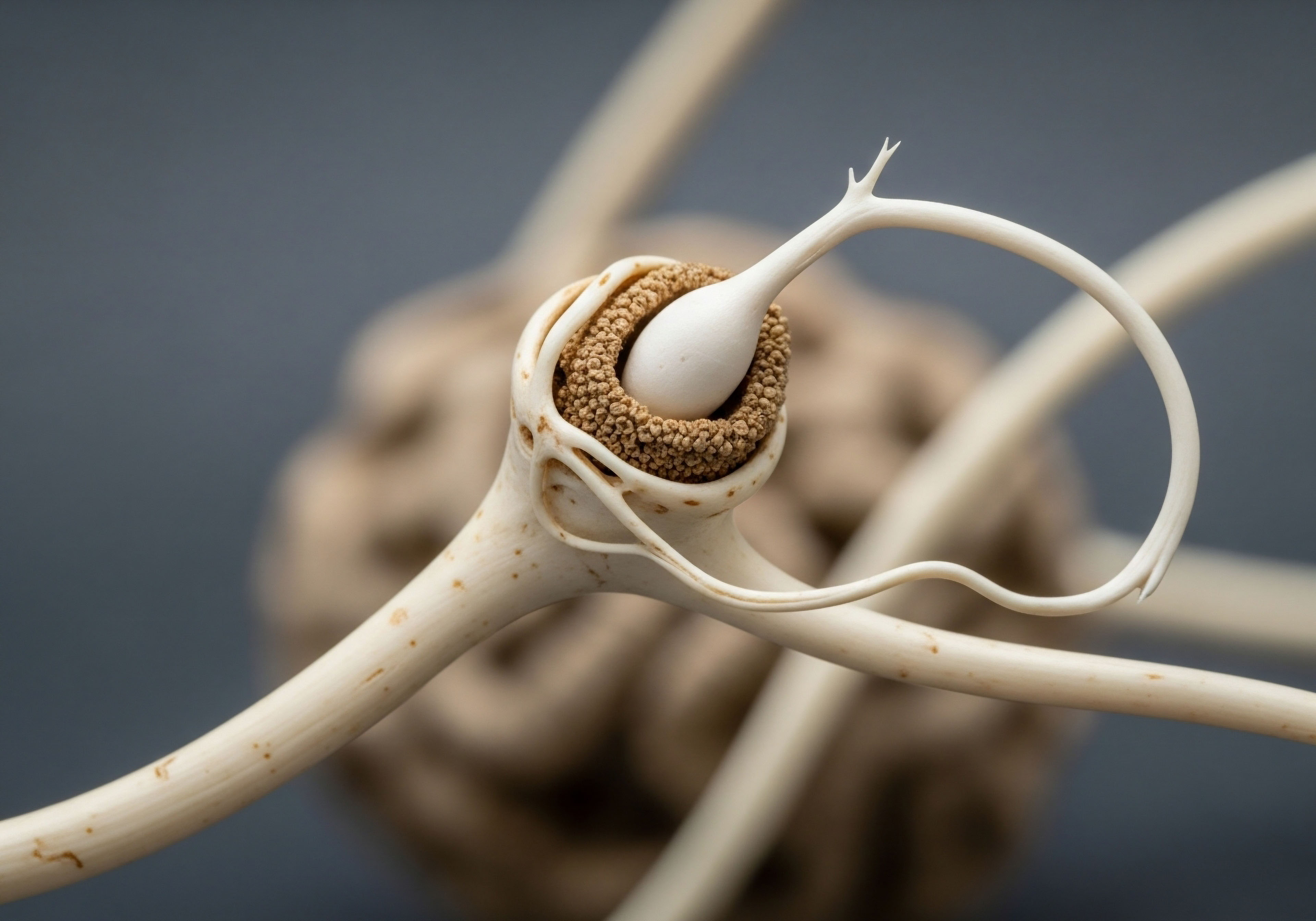

Fundamentals
Your personal health journey is a process of understanding the intricate signals your body sends. When you begin a protocol involving therapeutic peptides, you are engaging with some of the most precise signaling molecules in your biology. These molecules are delicate by design, their structure directly linked to their function.
The moment a peptide is reconstituted ∞ brought into a liquid solution ∞ it begins a countdown. Its effectiveness depends entirely on preserving its precise three-dimensional shape. Think of it as a key. If the key’s shape is compromised, it can no longer fit the lock it was designed for. Proper storage is the practice of protecting that key.
The environment you create for your reconstituted peptide Meaning ∞ A reconstituted peptide refers to a lyophilized, or freeze-dried, peptide preparation dissolved in a sterile diluent, commonly bacteriostatic water, returning it to a liquid state suitable for administration. solution is the primary determinant of its viability. These molecules are susceptible to a collection of environmental pressures that can systematically degrade them. Temperature, light, and even the type of container they are in can initiate a cascade of chemical reactions that render them inert.
The goal is to create a state of suspended animation, slowing these degradative processes to a near halt. This ensures that each dose you administer carries the full potential of the protocol, allowing your body to receive the intended biological message without distortion or loss of signal.
Proper storage is the foundational practice that ensures the full biological potential of a therapeutic peptide is delivered with every dose.
Understanding the rationale behind cold storage is the first step. Lowering the temperature of the solution dramatically slows down molecular motion. This reduction in kinetic energy minimizes the opportunity for degradative chemical reactions like hydrolysis, where water molecules break down the peptide bonds, or oxidation, where reactive oxygen species damage sensitive amino acid residues.
By placing your reconstituted peptide in a controlled, cold, and dark environment, you are actively preserving its structural and functional integrity. This simple action is central to the success of your wellness protocol, ensuring the connection between the therapeutic agent and its intended physiological response remains strong and clear.

What Is the Primary Goal of Peptide Storage?
The primary objective when storing reconstituted peptides Meaning ∞ Reconstituted peptides are lyophilized compounds restored to a liquid, injectable form by adding a specific diluent, typically bacteriostatic water. is the preservation of their molecular structure. Peptides are composed of specific sequences of amino acids, and their biological function is dictated by their unique folded shape. Once reconstituted into a liquid, peptides become vulnerable to various forms of degradation that can alter this shape, effectively deactivating them. These degradation pathways include chemical changes to the amino acids themselves and physical changes like aggregation, where peptide molecules clump together.
Therefore, every storage practice is designed to mitigate the factors that accelerate this degradation. The core principles revolve around controlling the peptide’s immediate environment to minimize chemical and physical instability. This involves managing temperature, protecting the solution from light, and preventing contamination.
By adhering to these practices, you ensure the peptide remains in its active, functional state from the moment it is reconstituted until the moment it is administered. This meticulous attention to detail is what allows the peptide to perform its intended role within your body’s complex endocrine and metabolic systems.

Key Environmental Factors in Peptide Stability
Three environmental factors have the most significant impact on the stability of a reconstituted peptide solution. Mastering control over these elements is the key to maximizing the therapeutic window of your protocol.
- Temperature ∞ This is the most critical factor. Lower temperatures slow down the rate of all chemical reactions, including those that degrade peptides. Refrigeration is standard, while freezing can extend stability for longer periods, though it introduces other considerations like the stress of freeze-thaw cycles.
- Light ∞ Exposure to light, particularly UV light, can provide the energy needed to trigger photodegradation. This process can cause changes to the primary structure of the peptide, especially affecting amino acids with aromatic rings like tryptophan and tyrosine, leading to a loss of bioactivity.
- Oxygen ∞ Atmospheric oxygen can cause oxidative damage to susceptible amino acid residues, most notably methionine and cysteine. This is why peptides are often handled in a way that minimizes air exposure, and storage vials are kept tightly sealed.


Intermediate
Once a peptide is reconstituted, it enters a state of heightened vulnerability. The lyophilized (freeze-dried) powder is a state of suspended animation, exceptionally stable due to the absence of water. The addition of a solvent, typically bacteriostatic water, awakens the molecule, making it biologically available while simultaneously exposing it to a host of degradation pathways.
Understanding these pathways is central to appreciating the science behind proper storage protocols. The two most immediate threats to a peptide’s integrity in solution are hydrolysis and oxidation.
Hydrolysis is the cleavage of the peptide bonds that form the backbone of the molecule. This reaction is catalyzed by the presence of water and is highly dependent on the pH of the solution. Certain amino acid sequences are particularly susceptible.
For instance, a sequence containing an aspartic acid (Asp) residue can be over 100 times more labile than other peptide bonds, making it a hotspot for degradation. Oxidation targets specific amino acid side chains. Methionine (Met) and cysteine (Cys) are the most common victims, with their sulfur-containing groups being readily oxidized.
This process can be accelerated by exposure to atmospheric oxygen and the presence of trace metal ions in the solution. Proper storage protocols are a direct countermeasure to these inevitable chemical processes.

Comparing Storage States
The distinction between lyophilized and reconstituted peptide stability Meaning ∞ Peptide stability refers to a peptide’s inherent capacity to maintain its original chemical structure, three-dimensional conformation, and biological activity over a specified period and under defined environmental conditions, such as temperature, pH, or exposure to enzymes. is a study in chemical kinetics. The removal of water in the lyophilization process dramatically reduces molecular mobility and eliminates the primary reactant for hydrolysis, granting the peptide a significantly longer shelf life. Once water is reintroduced, the stability timeline shortens considerably.
| Peptide State | Recommended Temperature | Typical Shelf Life | Primary Degradation Risks |
|---|---|---|---|
| Lyophilized (Powder) | -20°C to -80°C | Months to Years | Moisture, Light, Oxygen |
| Reconstituted (Liquid) | 2°C to 8°C (Refrigerated) | Days to Weeks | Hydrolysis, Oxidation, Aggregation, Contamination |

The Critical Role of Ph and Buffers
The pH of the reconstitution solvent is a critical variable that directly influences the rate of several degradation pathways. Most peptides have an optimal pH range for stability, typically between pH 4 and 6. Within this slightly acidic window, the rates of both deamidation Meaning ∞ Deamidation refers to a non-enzymatic chemical reaction involving the removal of an amide group from specific amino acid residues, primarily asparagine and glutamine, within proteins or peptides. (a common degradation pathway for asparagine and glutamine residues) and hydrolysis are often minimized.
Deamidation, for example, proceeds through a cyclic imide intermediate, a reaction that is catalyzed by basic conditions (pH > 8). Storing a peptide solution at an inappropriate pH can rapidly accelerate its degradation.
The pH of a peptide solution directly governs the rate of destructive chemical reactions, making the choice of a sterile, pH-appropriate solvent a critical step.
This is why sterile or bacteriostatic water, which is typically close to neutral or slightly acidic, is the standard for reconstitution. Using buffers to maintain a specific pH can further enhance stability, especially for peptides that are known to be sensitive to pH fluctuations.
A buffered solution resists changes in pH that might occur from exposure to atmospheric carbon dioxide or other contaminants. This level of control is essential for preserving the peptide’s chemical integrity and ensuring its biological activity remains intact for the duration of its use.

Best Practices for Reconstituted Peptide Solutions
Adhering to a strict set of handling and storage practices is essential for preserving the potency of reconstituted peptides. These guidelines are designed to mitigate the risks of chemical and physical degradation, as well as microbial contamination.
- Refrigerate Immediately ∞ Once reconstituted, the peptide solution should be immediately stored in a refrigerator at a consistent temperature between 2°C and 8°C. This is the single most effective step to slow degradation.
- Protect From Light ∞ Store vials in a dark place, such as their original box or a light-blocking container, to prevent photodegradation.
- Avoid Freeze-Thaw Cycles ∞ While freezing can extend shelf life, the process of freezing and thawing can damage the peptide’s structure. If you must freeze the solution, it is best to aliquot it into single-dose volumes to avoid repeated cycles.
- Maintain Sterility ∞ Use sterile techniques during reconstitution. Wipe the vial septum with an alcohol pad before each use to prevent bacterial contamination, which can both degrade the peptide and pose a health risk.
- Minimize Agitation ∞ Handle vials gently. Vigorous shaking or agitation can cause physical stress, leading to the aggregation of peptide molecules, which renders them inactive.


Academic
The stability of a peptide in an aqueous environment is a complex function of its primary amino acid sequence Meaning ∞ The amino acid sequence is the precise, linear order of amino acids linked by peptide bonds, forming a polypeptide chain. and the physicochemical conditions of the solution. Degradation is not a random event; it follows predictable chemical pathways, the kinetics of which are influenced by temperature, pH, and the presence of catalysts.
A deep understanding of these pathways is fundamental to the design of stable peptide therapeutics and the implementation of effective storage protocols. The principal non-enzymatic degradation routes are hydrolysis, deamidation, isomerization, and oxidation. Each of these pathways results in a modification of the peptide’s covalent structure, which can lead to a partial or total loss of biological function.
Hydrolysis of the peptide backbone is a significant concern, particularly at aspartic acid (Asp) residues. The peptide bond C-terminal to an Asp residue is known to be particularly labile under acidic conditions. This sequence-specific vulnerability means that the primary structure of a peptide can dictate its inherent stability.
Another critical pathway is the deamidation of asparagine (Asn) and glutamine (Gln) residues. Asn deamidation is particularly problematic as it proceeds through a five-membered succinimide ring intermediate. This intermediate can then hydrolyze to form either the original aspartic acid residue or, more problematically, an isoaspartic acid (isoAsp) residue. The introduction of an isoAsp residue alters the peptide backbone, which can disrupt the secondary and tertiary structure, leading to a loss of function and potentially inducing an immunogenic response.

Mechanisms of Peptide Degradation
The chemical degradation of peptides in solution is a multifaceted process involving several distinct reaction mechanisms. Each pathway is influenced by a unique set of factors, and the primary structure of the peptide often determines its susceptibility to each type of degradation. Understanding these mechanisms at a molecular level is crucial for developing strategies to enhance peptide stability.
| Degradation Pathway | Affected Residues | Primary Catalysts | Resulting Modification |
|---|---|---|---|
| Deamidation | Asparagine (Asn), Glutamine (Gln) | pH (base-catalyzed), Temperature | Formation of Aspartic/Glutamic acid or Isoaspartic/Isoglutamic acid |
| Oxidation | Methionine (Met), Cysteine (Cys), Tryptophan (Trp) | Oxygen, Metal Ions, Light | Formation of sulfoxides, disulfides, or kynurenine |
| Hydrolysis | Aspartic Acid (Asp), Serine (Ser) | pH (acid/base catalyzed) | Cleavage of the peptide backbone |
| Isomerization | Aspartic Acid (Asp) | pH, Temperature | Conversion of L-Asp to D-Asp or isoAsp forms |

How Does Sequence Influence Degradation Kinetics?
The rate of degradation is profoundly influenced by the local amino acid sequence. The deamidation of an Asn residue, for example, is significantly accelerated when it is followed by a small, flexible amino acid like glycine (Gly).
The Asn-Gly sequence is considered a ‘hot spot’ for deamidation because the flexibility of the glycine residue allows the peptide backbone to more easily adopt the conformation required for the formation of the succinimide intermediate. Similarly, the presence of a proline (Pro) residue next to an aspartic acid (Asp) residue can influence the rate of hydrolysis.
The primary amino acid sequence of a peptide dictates its intrinsic chemical stability, with specific ‘hot spot’ sequences serving as focal points for accelerated degradation.
These sequence-dependent effects have significant implications for the development of therapeutic peptides. Strategies to improve stability often involve modifying the peptide’s primary sequence to remove these labile sites. This can be achieved by substituting a susceptible amino acid with a more stable one.
For instance, replacing an Asn residue with a Gln or another stable amino acid can dramatically increase the shelf life of a peptide in solution. This approach, known as rational peptide design, is a cornerstone of modern pharmaceutical development, allowing for the creation of peptide analogs with enhanced stability and improved therapeutic profiles.

The Impact of Lyophilization and Excipients
Lyophilization, or freeze-drying, is a standard method for preserving peptides for long-term storage. The process involves freezing the peptide solution and then reducing the surrounding pressure to allow the frozen water to sublimate directly from the solid phase to the gas phase. This removes the water that is essential for hydrolytic degradation pathways.
However, the process itself can introduce stresses, such as freezing and dehydration, which can lead to aggregation or conformational changes. To mitigate these stresses, cryoprotectants and lyoprotectants are often included in the formulation.
These excipients are inactive ingredients that help to stabilize the peptide during the lyophilization process and in the final dried state. Sugars like sucrose or trehalose are common choices. They form an amorphous, glassy matrix that immobilizes the peptide, preventing aggregation and protecting it from mechanical stress.
Bulking agents like mannitol may also be added to ensure the structural integrity of the lyophilized cake. The selection of appropriate excipients is a critical aspect of formulation science, ensuring that the peptide remains stable and can be successfully reconstituted without loss of activity.

References
- Patel, K. and R. T. Borchardt. “Chemical pathways of peptide degradation. II. Kinetics of deamidation of an asparaginyl residue in a model hexapeptide.” Pharmaceutical research 7.7 (1990) ∞ 703-711.
- Manning, M. C. K. Patel, and R. T. Borchardt. “Chemical pathways of peptide degradation.” Pharmaceutical research 6.11 (1989) ∞ 903-918.
- Vlasak, J. and R. Ionescu. “Heterogeneity of monoclonal antibodies revealed by charge-sensitive methods.” Current pharmaceutical biotechnology 9.6 (2008) ∞ 468-481.
- Powell, M. F. “A compendium and analysis of protein stabilization by excipients.” Journal of pharmaceutical sciences 80.8 (1991) ∞ 759-765.
- Wang, W. “Lyophilization and development of solid protein pharmaceuticals.” International journal of pharmaceutics 203.1-2 (2000) ∞ 1-60.
- Cleland, J. L. M. F. Powell, and S. J. Shire. “The development of stable protein formulations ∞ a close look at protein aggregation, deamidation, and oxidation.” Critical reviews in therapeutic drug carrier systems 10.4 (1993) ∞ 307-377.
- Li, S. et al. “Chemical instability of protein pharmaceuticals ∞ mechanisms and stabilization strategies.” Journal of pharmaceutical sciences 88.10 (1999) ∞ 969-978.
- Chi, E. Y. S. Krishnan, and T. W. Randolph. “Physical stability of proteins in aqueous solution ∞ mechanism and driving forces in nonnative protein aggregation.” Pharmaceutical research 20.9 (2003) ∞ 1325-1336.

Reflection

Calibrating Your Personal Protocol
The information presented here provides a map of the chemical landscape your therapeutic peptides inhabit. It details the forces that seek to diminish their potential and the strategies to preserve it. This knowledge transforms the act of storage from a simple chore into a deliberate, informed practice.
It is the foundational layer of your protocol’s success. Your personal journey toward wellness is unique, defined by your own biology and goals. Understanding the principles of peptide stability allows you to become an active, knowledgeable participant in that journey.
It equips you to protect the integrity of your investment in your health, ensuring that the biological signals you are introducing to your system are clear, precise, and potent. This careful stewardship is the first and most critical step in realizing the full benefit of your personalized wellness protocol.














